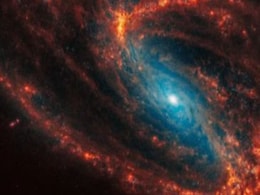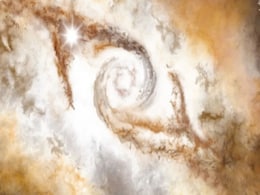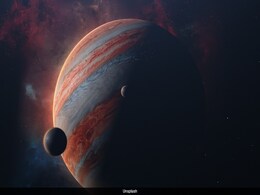Gas And Dust Disk
- All
- News
-

Astronomers Spot Signs of Baby Planets in a Star’s Mysterious Disk
Astronomers using Keck Observatory have imaged the dusty disk around HD 34282, a young star about 400 light-years away, revealing bright clumps and a 40 AU gap—clear signs of planet formation. The system provides a rare glimpse into early planetary birth, helping refine models of how gas and dust evolve into new worlds.
-

James Webb Telescope Spots Evidence of a Black Hole Carving a Massive Scar Through a Galaxy
Astronomers using JWST and ALMA discovered a 20,000-light-year-long contrail in galaxy NGC 3627. Scientists believe it was carved by a massive black hole traveling through the galactic disk, leaving behind a turbulent scar of dust and gas that may offer new clues to galaxy evolution.
-

Massive 200-Light-Year Cloud May Be Channeling Matter to the Milky Way's Core
Astronomers have discovered a massive, 200-light-year-wide cloud of gas and dust—dubbed the Midpoint cloud—hidden in the Milky Way. This giant molecular cloud appears to channel dense material into the galaxy’s core, possibly fueling star formation. The discovery offers rare insights into how matter flows from the galaxy’s disk to its turbu...
-

Jupiter Was Once Twice Its Size - And Its Magnetic Field Could Fry Spacecraft
Jupiter's early evolution and gravitational influence played a crucial role in shaping the solar system's structure and planetary orbits, earning it the title of the solar system's "architect."
-

T Tauri's Great Dimming: Astronomers Study Young Star's Potential Disappearance
The young star T Tauri, located 471 light-years from Earth, is experiencing a significant dimming event. The cause is a thick dust and gas disk blocking its light, with astronomers predicting it may disappear from view for up to a century. This event presents an opportunity for scientists to explore the chemical makeup of planet-forming regions wit...
-

"Very Exciting": In A First, Newborn Star's Spinning Disk Seen In Another Galaxy
Our sun and other stars form when a dense clump of interstellar gas and dust collapses under its own gravitational pull.
-

Red Dwarf Stars Giving Clues to Planet Formation
Australian astronomers have discovered disks of gas and dust around two relatively close red dwarf stars that could reveal clues about the formation of planets.
-

Astronomers Spot Signs of Baby Planets in a Star’s Mysterious Disk
Astronomers using Keck Observatory have imaged the dusty disk around HD 34282, a young star about 400 light-years away, revealing bright clumps and a 40 AU gap—clear signs of planet formation. The system provides a rare glimpse into early planetary birth, helping refine models of how gas and dust evolve into new worlds.
-

James Webb Telescope Spots Evidence of a Black Hole Carving a Massive Scar Through a Galaxy
Astronomers using JWST and ALMA discovered a 20,000-light-year-long contrail in galaxy NGC 3627. Scientists believe it was carved by a massive black hole traveling through the galactic disk, leaving behind a turbulent scar of dust and gas that may offer new clues to galaxy evolution.
-

Massive 200-Light-Year Cloud May Be Channeling Matter to the Milky Way's Core
Astronomers have discovered a massive, 200-light-year-wide cloud of gas and dust—dubbed the Midpoint cloud—hidden in the Milky Way. This giant molecular cloud appears to channel dense material into the galaxy’s core, possibly fueling star formation. The discovery offers rare insights into how matter flows from the galaxy’s disk to its turbu...
-

Jupiter Was Once Twice Its Size - And Its Magnetic Field Could Fry Spacecraft
Jupiter's early evolution and gravitational influence played a crucial role in shaping the solar system's structure and planetary orbits, earning it the title of the solar system's "architect."
-

T Tauri's Great Dimming: Astronomers Study Young Star's Potential Disappearance
The young star T Tauri, located 471 light-years from Earth, is experiencing a significant dimming event. The cause is a thick dust and gas disk blocking its light, with astronomers predicting it may disappear from view for up to a century. This event presents an opportunity for scientists to explore the chemical makeup of planet-forming regions wit...
-

"Very Exciting": In A First, Newborn Star's Spinning Disk Seen In Another Galaxy
Our sun and other stars form when a dense clump of interstellar gas and dust collapses under its own gravitational pull.
-

Red Dwarf Stars Giving Clues to Planet Formation
Australian astronomers have discovered disks of gas and dust around two relatively close red dwarf stars that could reveal clues about the formation of planets.








